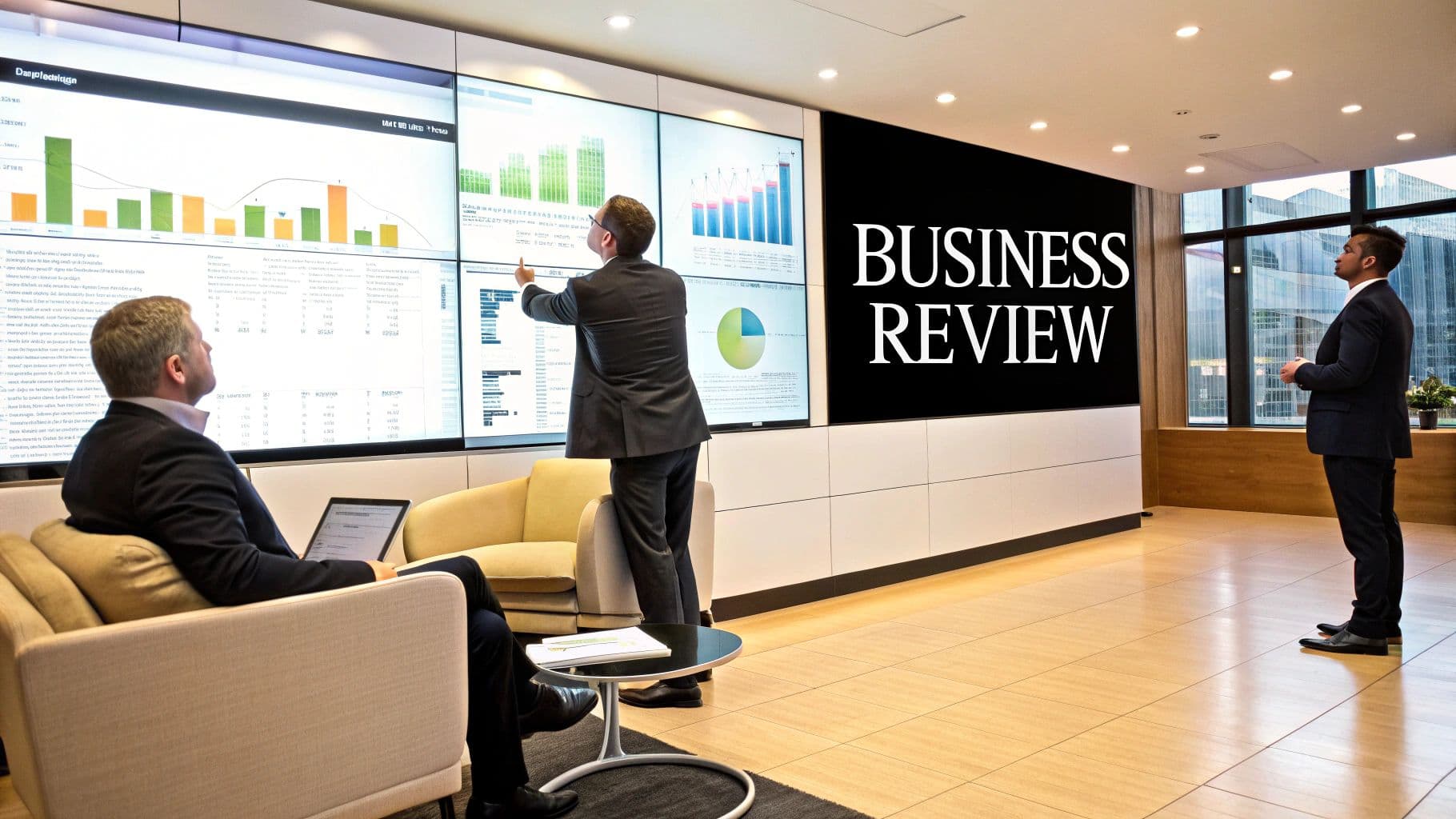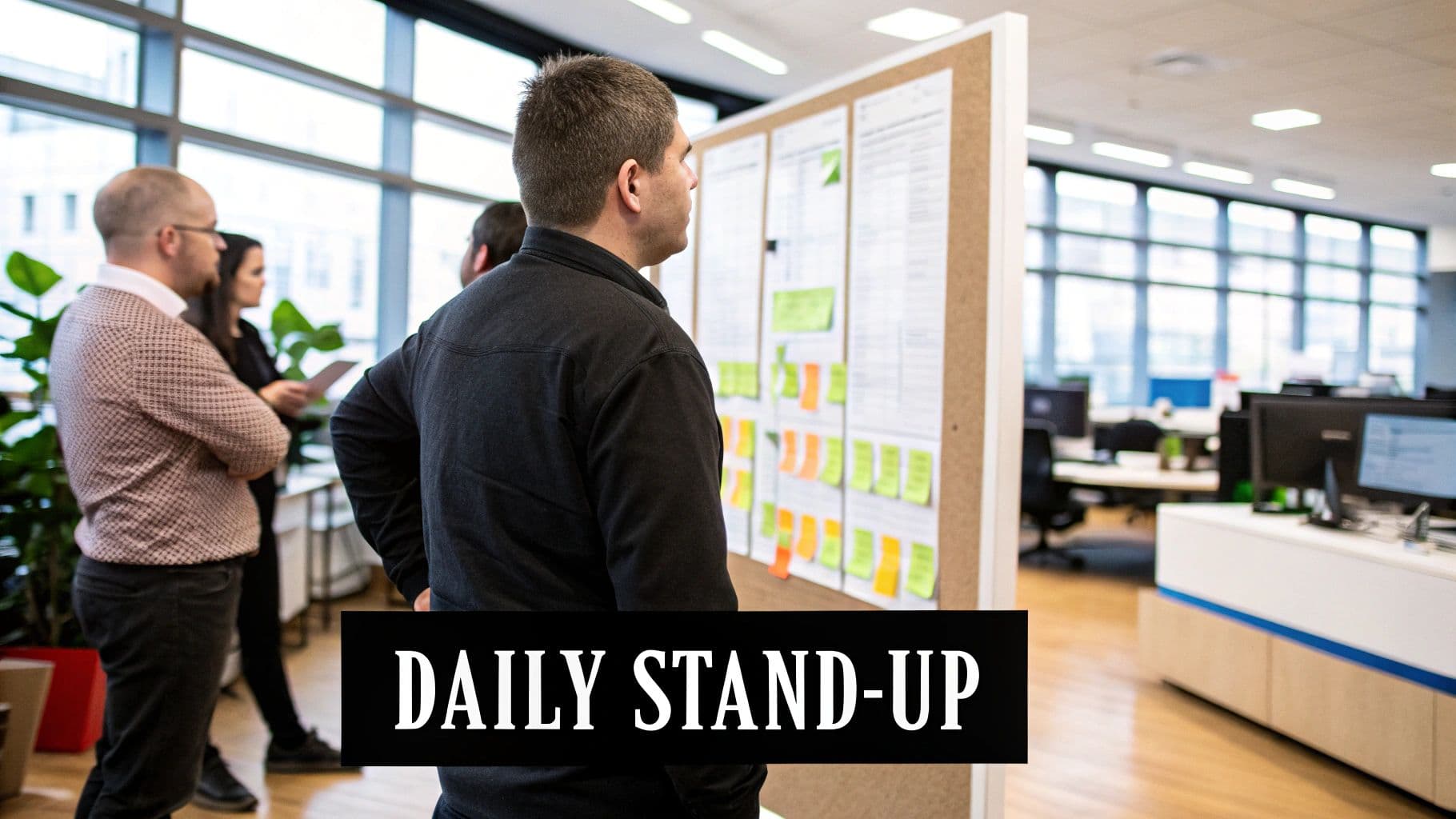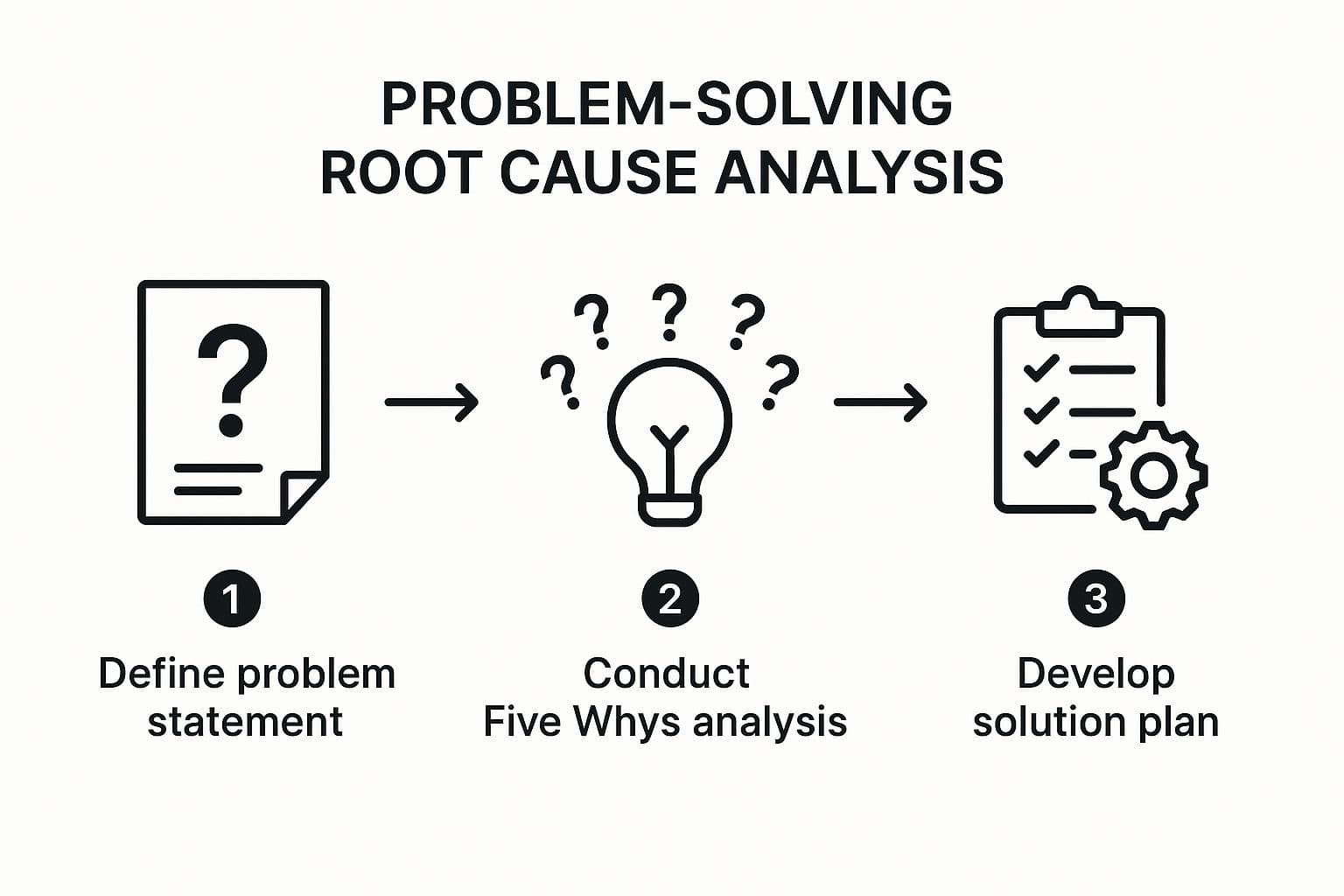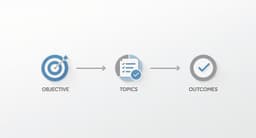Meetings often feel like a necessary evil, draining time and energy with little to show for it. The root cause is almost always a lack of structure. A well-crafted agenda is the single most effective tool for transforming chaotic discussions into focused, actionable outcomes. It’s the difference between a meeting that pushes a project forward and one that just fills a calendar slot.
This guide moves beyond generic outlines. We will break down six proven meeting agenda template examples, complete with deep strategic analysis and tactical insights you can apply immediately. You won't just see what to include; you'll understand why each component is critical for driving specific results. We will cover everything from strategic business reviews and high-stakes board meetings to creative brainstorming sessions and agile stand-ups.
Each template is a replicable framework designed to help you reclaim your time and ensure every conversation has a clear purpose. You'll find specific tactics and actionable takeaways to customize these agendas for your team's unique needs, whether you're a startup, a global enterprise, or a remote team. Let's dive into the blueprints that separate productive teams from the rest.
1. Strategic Business Review Meeting Agenda
The Strategic Business Review (SBR) is a high-stakes meeting designed for a systematic evaluation of business performance against strategic goals. Typically held monthly or quarterly, this format brings leadership together to analyze data, discuss progress on key initiatives, and make informed decisions about future direction. It’s a cornerstone of corporate governance, popularized by consulting firms like McKinsey & Company and used by industry leaders such as Microsoft and Amazon to maintain alignment and drive growth.

This meeting agenda template example is powerful because it forces a structured, data-driven conversation, moving beyond simple updates to deep strategic analysis. It ensures that discussions are forward-looking and tied directly to the company's most important objectives.
Why This Template Works
The SBR agenda excels by creating a predictable rhythm for performance assessment. Its structure is designed to cover all critical business functions, from financial health and sales performance to product development and market positioning. This comprehensive approach prevents blind spots and ensures that resource allocation decisions are based on a holistic view of the organization.
The format’s emphasis on pre-reading and strict time allocations keeps the meeting focused and efficient. Participants arrive prepared to discuss solutions rather than waste time absorbing raw data.
Actionable Takeaways for Your Next SBR
To implement this effectively, follow a few key principles inspired by top-performing organizations.
- Distribute Materials 48 Hours in Advance: Give all attendees ample time to review dashboards, reports, and preliminary analyses. This is non-negotiable for a productive session.
- Timebox Every Agenda Item: Assign a strict time limit to each topic. For example: Financial Review (15 mins), Sales Pipeline Analysis (20 mins), Strategic Initiatives Update (25 mins). Designate a timekeeper to enforce these limits.
- Focus on 'Why' and 'What's Next': The goal isn't just to report numbers. Each presenter should explain the story behind the data (the "why") and propose clear next steps.
- Document and Assign Action Items: Conclude the meeting by summarizing key decisions and assigning ownership for each action item. Using a tool that offers automated action item extraction can streamline this process and ensure accountability.
2. Lean Startup Stand-up Meeting Agenda
The Lean Startup Stand-up, also known as a daily scrum, is a rapid-fire, time-boxed meeting designed to maximize team synchronization with minimal time investment. Rooted in Agile and Lean methodologies, this format is the lifeblood of fast-moving tech companies and startups. Its core purpose is to quickly surface progress, identify immediate obstacles, and maintain daily alignment, a practice popularized by figures like Jeff Sutherland and Eric Ries and famously implemented by teams at Spotify, Google, and Slack.

This meeting agenda template example is exceptionally effective because it enforces brevity and focus. By limiting the meeting to 15 minutes and having each participant answer three simple questions (What did I do yesterday? What will I do today? What is blocking my progress?), it eliminates fluff and gets straight to the critical information needed to keep a project moving forward.
Why This Template Works
The stand-up agenda’s power lies in its disciplined structure and daily cadence. This rhythm creates a constant feedback loop, enabling teams to pivot quickly without waiting for a weekly review. The format fosters transparency and collective ownership, as everyone is aware of what their colleagues are working on and where help is needed.
Its physical nature, where participants traditionally stand, discourages long discussions and maintains a sense of urgency. This keeps the energy high and ensures the meeting stays on track, making it a perfect tool for development sprints, product launches, or any high-momentum project.
Actionable Takeaways for Your Next Stand-up
To run a stand-up that energizes rather than drains your team, adopt these proven tactics from agile leaders.
- Stick to the 15-Minute Rule: Start and end precisely on time, regardless of who is present. This discipline reinforces the meeting’s value and respects everyone’s schedule.
- Answer the Three Questions Only: Each person’s update should be a concise answer to what they accomplished, what they plan to do, and what’s in their way. Defer all problem-solving discussions until after the meeting, often called "the meeting after the meeting".
- Use a Visual Board: Whether it’s a physical whiteboard with sticky notes or a digital tool like Trello or Jira, a visual task board provides immediate context. Team members can reference it during their updates, making progress tangible and transparent.
- Rotate the Facilitator Role: Having a different team member lead the stand-up each day or week encourages engagement and shared responsibility. It prevents the meeting from becoming a one-way status report to a manager.
3. Problem-Solving Root Cause Analysis Agenda
The Problem-Solving Root Cause Analysis (RCA) meeting is a highly structured session designed to move beyond treating symptoms to uncover the fundamental cause of a complex problem. This agenda, rooted in Six Sigma and Lean methodologies, guides teams to systematically investigate an issue, identify its core origin, and develop lasting solutions. It has been a cornerstone of operational excellence for decades, championed by quality pioneers like W. Edwards Deming and famously implemented by companies like Toyota and General Electric to drive continuous improvement.
This meeting agenda template example is powerful because it enforces a disciplined, evidence-based approach to problem-solving. It shifts the focus from assigning blame to understanding and improving processes, creating a culture of psychological safety and collective ownership.
Why This Template Works
The RCA agenda’s strength lies in its systematic framework, which prevents teams from jumping to conclusions or implementing superficial fixes. By breaking down the problem into distinct stages, from a clear problem definition to a thorough “Five Whys” analysis, it ensures a comprehensive investigation. This methodical approach is crucial for tackling recurring issues that drain resources and hinder performance.
The format demands data collection before the meeting and encourages the inclusion of diverse perspectives, ensuring that the analysis is both informed and holistic. It transforms the meeting from a reactive complaint session into a proactive, solution-oriented workshop.
The process-flow infographic below illustrates the three core steps of a successful Root Cause Analysis agenda.

This visual guide emphasizes the logical progression from clearly defining the issue to systematically digging deeper for the true cause before brainstorming solutions.
Actionable Takeaways for Your Next RCA
To run an effective RCA session, adopt these best practices inspired by industry leaders in process improvement.
- Define the Problem Statement Clearly: Before the meeting, collaborate with key stakeholders to write a precise, measurable, and objective problem statement. For example, instead of "Website is slow," use "Website page load time for users in the EU region increased by 40% in Q3."
- Use Visual Tools to Map the Process: Utilize a whiteboard or a digital collaboration tool to visually map out the problem. Techniques like the Fishbone (Ishikawa) diagram or the Five Whys are essential for guiding the conversation and keeping everyone engaged.
- Focus on Process, Not People: Constantly reinforce that the goal is to find flaws in the process, not to blame individuals. This is critical for fostering an open and honest discussion where team members feel safe to share insights.
- Document and Validate Solutions: Once potential solutions are identified, create a clear action plan with owners, deadlines, and metrics for success. Thoroughly documenting the discussion is key; learning how to take better meeting notes can ensure no critical details are lost.
4. Creative Brainstorming and Innovation Workshop Agenda
The Creative Brainstorming and Innovation Workshop is a dynamic, participant-focused session engineered to unlock novel ideas and solve complex problems. Unlike traditional, rigid meetings, this format prioritizes psychological safety and structured creative exercises to generate a high volume of innovative solutions. Popularized by creative powerhouses like IDEO with their design thinking methodology and used by innovators such as Google and Pixar, this agenda transforms a meeting from a status report into an idea factory.

This meeting agenda template example is exceptionally effective because it breaks down the barriers to creative thinking. By providing a clear framework that encourages wild ideas and defers judgment, it empowers every participant to contribute freely, leading to unexpected breakthroughs that a more conventional meeting structure would stifle.
Why This Template Works
This agenda’s strength lies in its flexible structure, which blends individual and group activities to maximize cognitive diversity. It starts with setting the stage to establish a "judgment-free zone," then moves through specific ideation techniques like "Round Robin Brainstorming" or "SCAMPER" to ensure everyone participates. This prevents the common problem of a few dominant voices controlling the conversation.
The format is built on the principle of "divergence and convergence," where the group first generates a wide range of possibilities (divergence) before systematically filtering and refining them into actionable concepts (convergence). This ensures the creative process is not only imaginative but also productive and aligned with strategic goals.
Actionable Takeaways for Your Next Brainstorming Session
To run a successful innovation workshop, adopt practices from leading creative organizations.
- Establish a 'Yes, and...' Mindset: Ban critical language like "but" or "that won't work." Instead, instruct participants to build on each other's ideas using the improvisational principle of "Yes, and...". This fosters a collaborative and positive environment.
- Mix Individual and Group Ideation: Start with a few minutes of silent, individual brainstorming where everyone writes down ideas on sticky notes. Follow this with a group sharing session. This gives introverts a chance to contribute equally and prevents groupthink.
- Use Visual and Kinesthetic Tools: Don't just talk. Use whiteboards, sticky notes, markers, and even physical prototypes. Encourage participants to stand up and move around the room to keep energy levels high and stimulate different parts of the brain.
- Define Clear Problems and Constraints: Creativity thrives within boundaries. Start the session by clearly defining the specific problem to be solved or the goal to be achieved. For example, "How might we reduce customer onboarding time by 50% without hiring more staff?"
5. Board of Directors Governance Meeting Agenda
The Board of Directors Governance Meeting is a formal, high-stakes session designed to fulfill the board's fiduciary duties and provide strategic oversight. Held quarterly or annually, this agenda ensures that discussions adhere to legal requirements, corporate bylaws, and governance best practices. Its structure is essential for accountability, risk management, and long-term value creation, popularized by frameworks from the National Association of Corporate Directors and influenced by regulations like the Sarbanes-Oxley Act.
This meeting agenda template example is critical because it provides a formal framework for accountability between management and the company’s highest governing body. It ensures that discussions are legally compliant, strategically focused, and meticulously documented. This isn't just a meeting; it's a fundamental exercise in corporate stewardship, practiced by organizations from Apple under Tim Cook to major non-profits like the United Way.
Why This Template Works
This agenda's power lies in its formality and comprehensive scope. It creates a clear distinction between governance and operations, compelling the board to focus on strategic direction, major financial decisions, and risk oversight rather than day-to-day management. By allocating specific time for committee reports (e.g., Audit, Compensation) and executive sessions without management present, it fosters candid discussion and independent judgment.
The rigorous, structured format ensures all compliance and reporting obligations are met, protecting the organization and its directors from legal and financial risks. It transforms the board meeting from a series of presentations into a true governance forum where critical decisions are made and vetted with the highest level of scrutiny.
Actionable Takeaways for Your Next Board Meeting
To conduct an effective board governance meeting, structure and preparation are paramount. Adopt these best practices to elevate your board's performance.
- Distribute Board Books One Week in Advance: A comprehensive board book containing all reports, financial statements, and background materials is non-negotiable. Distributing it at least a week early allows directors to come fully prepared for substantive debate.
- Prioritize Strategic Oversight: Structure the agenda so that the bulk of the time is spent on forward-looking strategic issues, not just reviewing past performance. Frame discussion topics as decisions to be made or problems to be solved.
- Incorporate an Executive Session: Always include a private session on the agenda where independent directors can meet without the CEO or other management present. This creates a safe space for open dialogue on sensitive topics like executive performance and succession planning.
- Ensure Meticulous Minute-Taking: Board meeting minutes are legal documents. Ensure a corporate secretary is present to capture all motions, votes, and key decisions accurately. These minutes provide a crucial record of the board's diligence and adherence to its duties.
6. Project Kickoff and Planning Meeting Agenda
The project kickoff meeting is a critical first step for any new initiative, serving as the formal launch that aligns all stakeholders on goals, scope, and process. This agenda is designed to move beyond introductions and establish a solid foundation for execution. It's a structured session to define success, clarify roles, identify risks, and agree on a communication plan, used universally by organizations from NASA for mission planning to Apple for new product launches.
This meeting agenda template example is essential because it sets the tone and direction for the entire project lifecycle. It transforms a collection of individuals into a cohesive team with a shared understanding of the objectives, timeline, and their specific responsibilities, preventing costly misunderstandings and scope creep down the line.
Why This Template Works
The Project Kickoff agenda is effective because it forces clarity and commitment from day one. Its structure ensures that every critical project parameter is discussed and agreed upon, from the high-level project vision to the granular details of the first sprint or phase. By covering objectives, deliverables, timelines, and roles in a single session, it creates a unified point of reference for the entire team.
This format moves the project from an abstract idea to a concrete plan. The emphasis on documenting decisions in a project charter or kickoff summary ensures that verbal agreements are solidified, creating accountability and a clear path forward for everyone involved.
Actionable Takeaways for Your Next Project Kickoff
To run a successful kickoff based on best practices from the Project Management Institute (PMI) and top consulting firms, focus on these key actions.
- Define and Agree on the 'Why': Start by clearly articulating the project's purpose and the business value it delivers. Everyone must understand and agree on the primary objective before discussing the "how."
- Visually Map the Timeline: Use a Gantt chart, project roadmap, or simple timeline visual to walk through key phases, milestones, and deadlines. This makes the schedule tangible and helps identify potential bottlenecks early.
- Clarify Roles with a RACI Matrix: Explicitly define who is Responsible, Accountable, Consulted, and Informed for key tasks. This prevents confusion and ensures clear ownership.
- Document Everything Meticulously: The output of this meeting is as important as the meeting itself. Capture all decisions, action items, and open questions. Using a perfect meeting minutes format will ensure this critical information is preserved and distributed effectively, serving as your project’s foundational document.
Meeting Agenda Template Comparison
| Agenda Type | Implementation Complexity 🔄 | Resource Requirements ⚡ | Expected Outcomes 📊 | Ideal Use Cases 💡 | Key Advantages ⭐ |
|---|---|---|---|---|---|
| Strategic Business Review Meeting | High – Requires significant prep | Moderate – Data & leadership | Comprehensive performance & strategic review | Quarterly/monthly leadership reviews | Ensures business coverage & accountability |
| Lean Startup Stand-up Meeting | Low – Fast, time-boxed | Low – Minimal prep, short time | Quick blockers resolution & alignment | Daily team sync in agile/startup environments | Maximizes efficiency & momentum |
| Problem-Solving Root Cause Analysis | High – Structured, expert-led | Moderate to high – Facilitation | Root cause identification & sustainable solutions | Complex organizational problem solving | Systematic, data-driven problem resolution |
| Creative Brainstorming & Innovation | Moderate – Flexible but needs skill | Moderate – Facilitation & space | High-volume creative ideas & innovation | Innovation workshops & ideation sessions | Encourages creativity & team collaboration |
| Board of Directors Governance Meeting | High – Formal & regulated | High – Documentation & compliance | Legal/regulatory compliance & governance | Corporate board meetings requiring oversight | Ensures governance & legal compliance |
| Project Kickoff and Planning Meeting | Moderate to high – Detailed prep | Moderate – Stakeholders & documentation | Clear project alignment & accountability | New project launches & stakeholder alignment | Establishes project foundation & clarity |
From Agenda to Action: Supercharge Your Meeting Workflow
We've explored a diverse set of powerful meeting agenda template examples, from the high-stakes Board of Directors Governance Meeting to the fast-paced Lean Startup Stand-up. Each template serves as more than just a schedule; it's a strategic framework designed to guide conversation, focus energy, and drive specific outcomes. You've seen how a Project Kickoff agenda aligns teams from day one and how a Problem-Solving agenda drills down to root causes, preventing recurring issues.
The core lesson is that intentionality is everything. A well-crafted agenda transforms a meeting from a passive update into an active, productive work session. It sets expectations, allocates time wisely, and ensures every participant knows their role.
Key Takeaways for Immediate Application
Moving forward, remember these critical principles drawn from the examples:
- Purpose-Driven Structure: Always start with the end in mind. The agenda for a Creative Brainstorming session looks fundamentally different from one for a Strategic Business Review because their goals are worlds apart. Match your template to your objective.
- Time as a Resource: Every template we reviewed treated time as a valuable, finite resource. Allocating specific time blocks to each item creates a sense of urgency and discipline, keeping discussions on track.
- Clarity is Kindness: A great agenda provides clarity on topics, presenters, and desired outcomes. This preparation allows attendees to contribute thoughtfully rather than being caught off guard.
The true power of these templates is not in copying them verbatim, but in adapting their underlying strategic principles to your unique team and challenges. Use them as a starting point. Mix and match sections. Experiment and iterate until you find the perfect rhythm for your organization. By mastering the art of the agenda, you’re not just improving meetings; you're building a culture of efficiency, respect, and focused execution.
Bridge the Gap Between Discussion and Execution
Having the right agenda is the crucial first step, but the real test of a meeting’s success is what happens after everyone leaves the room. Manually transcribing notes, identifying action items, and sharing summaries can be a significant drag on momentum, allowing great ideas to fade before they are implemented. This is where modern AI tools can revolutionize your workflow.
Solutions like Fireflies.ai, Otter.ai, and Notta automatically record, transcribe, and summarize your conversations. This ensures no critical detail, decision, or assigned task is ever lost in translation. To help you choose the right solution, our 'Summarize Meeting' comparison guide provides a detailed breakdown of over 20 top tools. By pairing a strategic agenda from this article with an automated summarization tool, you create a seamless, powerful system. You can finally close the loop from planning to execution, making every single meeting a true catalyst for measurable progress.
Ready to turn your well-planned meetings into actionable outcomes instantly? Explore our detailed comparisons at Summarize Meeting to find the perfect AI tool that automatically transcribes and summarizes your discussions. Visit Summarize Meeting to connect your agenda to action today.
🔗 Related Reading
For more insights on meeting productivity and AI tools:

